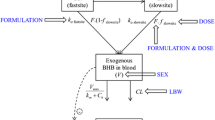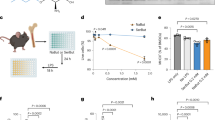Abstract
Purpose: To define the plasma concentrations of butyrate achieved and the profile of plasma butyrate concentrations versus time in mice and rats treated with tributyrin or sodium butyrate. Methods: Female CD2F1 mice were treated with tributyrin by oral gavage or with sodium butyrate by i.v. bolus or oral gavage. Oral tributyrin doses delivered to mice were 3.1, 5.2, 7.8, and 10.3 g/kg. Intravenous sodium butyrate doses were 0.31, 0.62, 0.94, and 1.25 g/kg. Oral sodium butyrate was given to mice at 5 g/kg. Subsequently, similar studies were performed in female Sprague-Dawley rats. Rats were given tributyrin by oral gavage at doses of 3.6, 5.2, or 10.3 g/kg or sodium butyrate i.v. at a dose of 500 mg/kg. Plasma butyrate concentrations were determined by gas chromatography. Results: In mice, oral dosing with tributyrin resulted in detectable plasma butyrate concentrations as early as at 5 min after treatment and produced peak plasma butyrate concentrations at between 15 and 60 min after dosing. Peak plasma butyrate concentrations increased proportionally with increasing tributyrin dose, but as the oral tributyrin dose increased there was a greater than proportional increase in the area under the curve of plasma butyrate concentrations versus time (AUC). At a tributyrin dose of 10.3 g/kg, plasma butyrate concentrations peaked at approximately 1.75 mM and remained ≥1 mM for between 10 and 60 min after dosing. However, approximately 10% of mice treated with this dose died acutely. At a tributyrin dose of 7.8 g/kg, plasma butyrate concentrations reached approximately 1 mM by 15 min after dosing and remained between 0.8 and 1 mM until 60 min after dosing. No mouse treated with this dose died acutely. Mice given tributyrin doses of 5.2 and 3.1 g/kg achieved peak plasma butyrate concentrations of approximately 0.9 and 0.5 mM, respectively, by 45 min after dosing. Plasma butyrate concentrations in these mice remained above 0.1 mM until 120 and 90 min after dosing, respectively. The four i.v. doses of sodium butyrate resulted in plasma concentration-time profiles that also indicated nonlinear pharmacokinetics and were well described by a one-compartment model with saturable elimination. Values recorded for the Michaelis-Menten constant (K m) and the maximal velocity of the process (Vmax) ranged between 1.02 and 5.65 mM and 0.60 and 1.82 mmol/min, respectively. Values noted for the volume of the central compartment (Vc) varied between 0.48 and 0.72 l/kg. At 1.25 g/kg, i.v. sodium butyrate produced peak plasma butyrate concentrations of 10.5–17.7 mM, and plasma butyrate concentrations remained above 1 mM for 20–30 min. Sodium butyrate delivered orally to mice at 5 g/kg produced peak plasma butyrate concentrations of approximately 9 mM at 15 min after dosing and plasma butyrate concentrations exceeding 1 mM for 90 min after dosing. In rats the 10.3-g/kg oral dose of tributyrin produced peak plasma butyrate concentrations of approximately 3 mM by 75 min after dosing and butyrate concentrations excedding 1 mM from 30 to 90 min after dosing. The plasma butyrate concentrations produced in rats by 5.2- and 3.6-g/kg doses were appropriately lower than those produced by the 10.3-g/kg dose, and there was no evidence of nonlinearity. The 500-mg/kg i.v. dose of sodium butyrate produced peak plasma butyrate concentrations in rats of approximately 11 mM, and the decline in plasma butyrate concentrations with time after dosing was consistent with saturable clearance. Conclusion: These studies document the ability to use oral administration of tributyrin to achieve pharmacologically relevant concentrations of butyrate in rodent plasma. They also document the nonlinear nature of butyrate clearance. These data are being used in the design of clinical trials of oral tributyrin in patients with malignancies and hemoglobinopathies.
Similar content being viewed by others
Author information
Authors and Affiliations
Additional information
Received: 27 July 1998 / Accepted: 3 November 1998
Rights and permissions
About this article
Cite this article
Egorin, M., Yuan, ZM., Sentz, D. et al. Plasma pharmacokinetics of butyrate after intravenous administration of sodium butyrate or oral administration of tributyrin or sodium butyrate to mice and rats. Cancer Chemother Pharmacol 43, 445–453 (1999). https://doi.org/10.1007/s002800050922
Issue Date:
DOI: https://doi.org/10.1007/s002800050922




